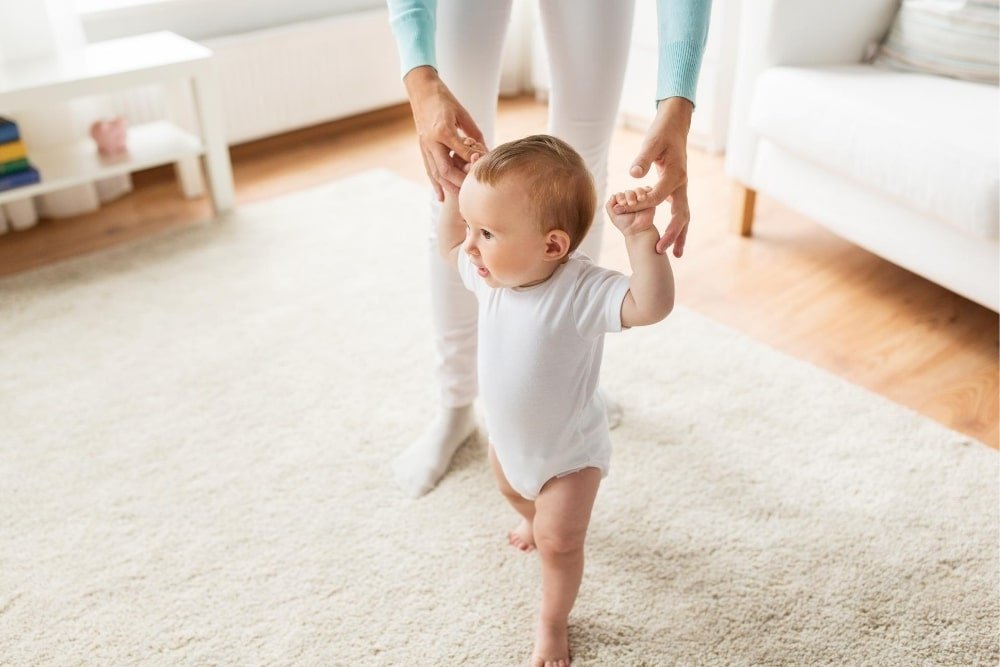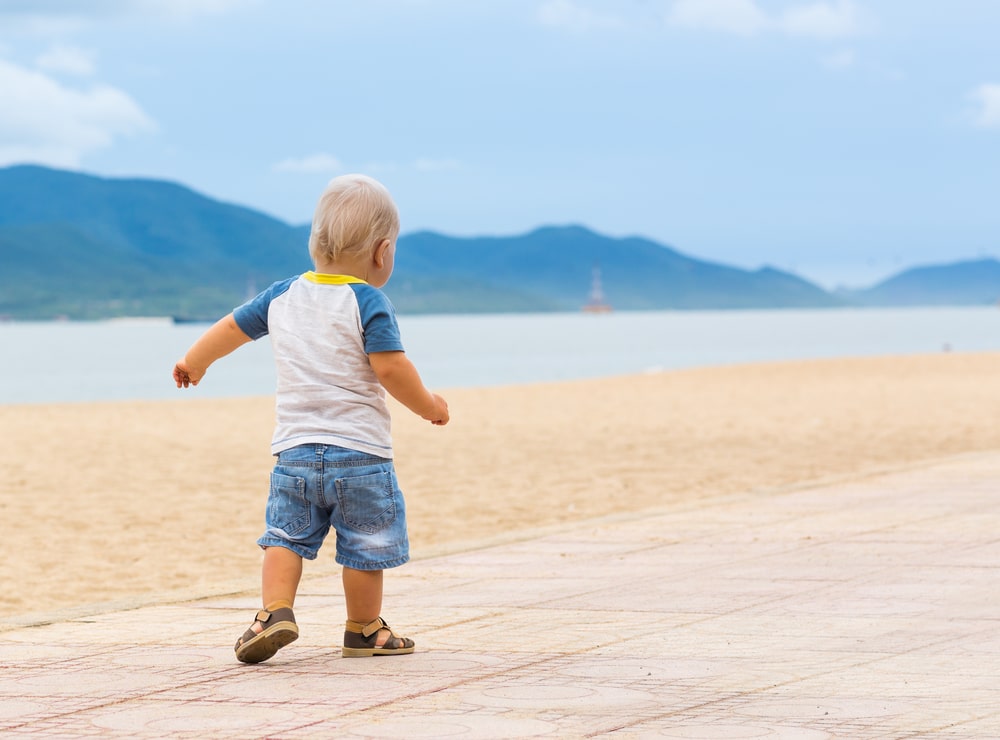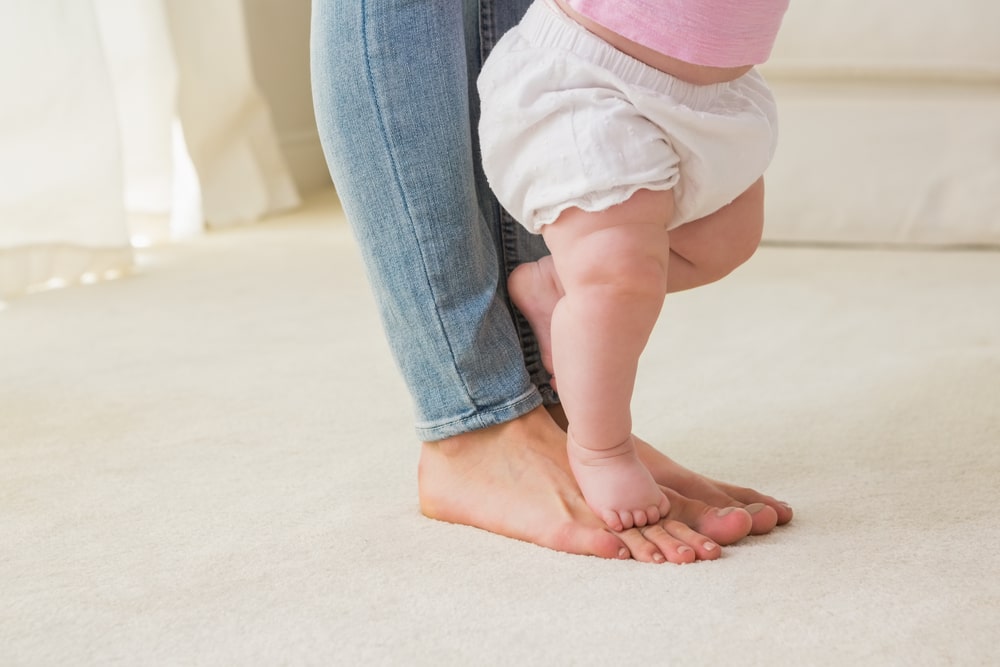It is very exciting when your baby starts learning new things. Your baby reaches many milestones in their first year: sitting up, crawling, babbling, and sometimes even walking.
All babies are unique and not every baby will reach the key milestones at exact same time. Some babies walk when they are nine months old and others are still only crawling at 18months of age. Every baby is different and will reach their milestones in their own time.
However, some children do develop strange habits, especially when it comes to their mobility, and it can be difficult to decipher whether this is a part of their normal development or not.
Instead of crawling, some babies shuffle on their bottom, others will crawl with their butt sticking up in the air and some babies will walk on their knees and not their feet.
Babies walking on their knees is common and a normal part of their development. If your baby is walking on their knees you do not need to be immediately concerned. But you might be wondering how to stop your baby from walking on their knees.
Why Do Babies Walk On Their Knees?
Babies are born with primitive instincts and some babies will walk on their knees. Walking on their knees helps babies to balance their bodies, it can be tricky to stay upright when learning to walk on their feet.
Knee walking can feel easier for babies as they can maneuver up onto their knees more easily than standing up on their feet.
If your baby is walking on their knees you do not have to worry, it can be funny to watch and your baby may just be taking their time and preparing themselves to walk properly.
However, if your child’s knee walking persists into their second year of life then you will need to get some advice from a medical professional.
View in gallery
When Do Babies Start Walking?
If your baby is walking on their knees but not walking properly yet, try not to panic. Babies meet the walking milestone at different ages and some will walk on their knees or continue to just crawl for a little while longer than others.
Here is a list of the different walking stages you can expect your baby to go through:
Standing/bouncing with support
Before your baby can walk they start trying out different positions and movements in their body. This exploration of movement will help their muscles to grow and strengthen ready for walking.
One of the early stages of walking preparation is when you have your baby standing in your lap and you hold them upright. Some babies as young as six months will enjoy standing in your lap with support and may even start bouncing up and down.
Babies over six months will also start experimenting with crouching positions and bouncing up and down while sat on their knees. These movements will help them to strengthen the muscles they need for walking and also help them to develop a sense of balance.
Crawling
Not all babies crawl before they can walk. Some babies go straight to pulling themselves upright and cruising around the furniture and others knee walk before they start walking.
However, many babies will crawl and this is how they get around before learning how to walk. Crawling again strengthens your baby’s leg and core muscles which they need to be strong for when they begin taking their first steps.
Babies often start crawling between six and nine months old, however, it is important to remember there is no set time limit and all babies are different.
Pulling up/cruising on furniture
View in gallery
Some babies skip straight to this stage and others will progress from crawling to pulling themselves up on the furniture.
This stage of walking usually happens when your child has built up enough upper body strength and leg muscle to be able to pull themselves upright.
Babies will grab onto the edge of a coffee table, couch, or another low-standing piece of furniture and pull themselves up to standing. Once your baby is confident getting into this position they will start ‘walking’ around the furniture.
When cruising, babies will hold onto the furniture like it is a handrail and take steps with their feet without letting go.
Standing with no support
Cruising helps babies to grow in confidence. With the support of the furniture, babies can get used to being up on two feet and moving around in an upright position.
The next stage is when your baby finds his confidence and tried to stand unassisted. Standing without support is a sign your child is getting closer to reaching their walking milestone.
However, walking is tricky, babies need to learn balance and coordination and have muscles strong enough to help them to walk. Babies may continue to walk on their knees after they have learned to stand with no support, simply because it is a much easier way for them to get from A to B.
Walking with assistance
Now your baby has started to figure out how to take steps from all that cruising around the coffee table and their balance is getting better, they may be ready to start walking with assistance.
You can hold your baby’s hand, or walk behind them with your hands on their waist or offer them a plush toy to use for support.
Walking with assistance allows your baby to put everything they have been learning to practice and will give them the confidence they need to start taking steps unaided.
Your baby still prefers to knee walk at this stage as it is still a quicker option for when they want to move around.
Walking
View in gallery
Finally, your baby is ready to start walking. Their muscles are strong, they have worked out how to stay upright (most of the time) and they are growing in confidence every day.
You won’t suddenly one day have a toddler running all over the house, but once your baby has started taking their first steps, it won’t take them long to master their new skill and they will be wanting to walk everywhere.
How To Stop Your Baby Knee Walking?
As you can see, babies learn to walk over several months. Your child will need to develop lots of different body movements and increase their muscle tone before they are able to stand upright and walk on their feet.
If your baby is knee walking, this may just be their favorite way to get around while they are busy also building their strength and balance in preparation for walking.
You do not need to worry if your baby is walking on their knees, this is a very common occurrence in pre-walkers and once they figure out how to walk properly they will leave their quirky knee walking habit behind.
If you are keen to get your baby up on their feet and taking their first wobbly steps, there are certain things you can do to encourage them.
Praise your baby
Give your baby lots of praise whenever they do something that will help them learn to walk. If your baby starts cruising give them lots of smiles and celebrate their achievement.
If they stand up unsupported then give them a little round of applause, show them that you’re proud and excited to see them growing in confidence.
Your praise and encouragement will give your baby a confidence boost and they will want to practice their new skill, even more, to get more fuss and attention from you. Once your baby is up on their feet, they should begin to walk on their knees less often.
Let them explore
View in gallery
If your baby is always in a stroller, car seat, or baby carrier, you are not giving them the opportunity to practice their walking skills.
Your baby will take longer to build up their strength if they are not getting much time down on the floor, exploring movement with their bodies. Your baby has mastered knee walking, now you need to give them time and space to learn how to stand up on their feet and walk unaided.
Keeping your baby close for cuddles in the sling is lovely and will build your bond but you need to give your child plenty of time to practice moving around independently too.
Allow your baby to use a push toy
A shiny new toy may be all the incentive your baby needs to get up from their knees and start walking on their feet.
Using a push toy will encourage your baby to walk on their feet instead of their knees as they will need to be stood up to push it properly. A push toy will encourage your baby to start taking steps on their feet and also help them to develop their balance and strength.
Exercise and games
Certain exercises and games can encourage your baby to come out of their knee walking comfort zone and start standing up. You can lie your baby on their back and cycle their legs while singing nursery rhymes like The Wheels On The Bus, for example.
You could pretend to be frogs and encourage your baby to ‘leap’ up from a crouching position, helping them to get used to standing up tall. Games that involve reaching up high or moving their legs around will help your baby to build strength and balance in a fun, unpressured way.
Put toys out of their reach
It may seem a bit mean but putting your baby’s favorite things just out of their reach may encourage them to start standing up.
For example, maybe your baby can’t reach their dolly on the coffee table if they stay down on their knees, but when they pull themselves up they can reach it easily.
Your baby will get lots of praise from you when they pull themselves up onto their feet and they will also get their toy back. Play this game regularly and your baby will grow in confidence and start to find it easier to pull themselves up and begin to stop walking on their knees as often.
Don’t rush
View in gallery
Your baby will start walking when they are ready. Walking is not an easy skill to perfect, your baby needs to be thinking about lots of different things: staying upright, lifting their legs, moving their feet – it’s harder than it looks!
Not all babies walk at the same time and you don’t need to stress if your baby is taking a little longer than their peers. However, if you are concerned about your baby’s development then you can speak with your pediatrician.
FAQs
When do babies pull up to their knees?
According to a study by the World Health Organization, most babies begin to crawl on their hands and knees between 6 and 11 months. Almost half of all babies begin crawling by 8.3 months.
Is it normal for a baby to crawl on the knee?
Many babies crawl using one knee and one foot – this is called an asymmetrical pattern and is something that should be avoided.
It may be caused by an underlying asymmetry in the muscles, hips, or in their body awareness. This type of crawling pattern encourages your baby to use one side of their body more than the other.
Is holding a baby in standing position bad?
While your baby is young they do not have the natural strength to hold themselves in a standing position. But in a few months, they will have the strength to bear their own weight and may begin to bounce up and down when you hold them with their feet touching a hard surface.
The Final Thought
Babies and toddlers will sometimes walk on their knees, this can be concerning for parents but often it is nothing to worry about.
Babies all learn to walk at their own pace and will often pick up funny little habits while they are preparing their bodies for walking. Knee walking is common but there are many things you can do to try and encourage your baby to stand up and walk correctly.
Knee walking is rarely a cause for concern but if your baby continues to show no sign of standing and walking as they progress through their second year of life, seek help from your pediatrician who can offer you professional advice.






